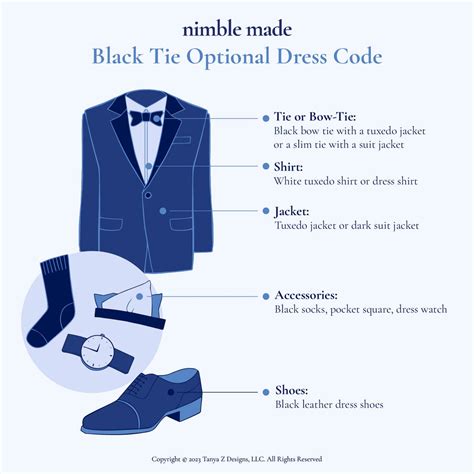When you receive an invitation to a formal event, the dress code can be a bit confusing. What’s the difference between formal and black tie optional? What should you wear to each type of event? Don’t worry, we’ve got you covered. In this article, we’ll break down the differences between formal and black tie optional dress codes and provide you with tips on what to wear to each type of event.

What is Formal Dress Code?
Formal dress code is the most formal type of dress code. It is typically reserved for very special occasions, such as weddings, black-tie galas, and awards ceremonies. For men, formal dress code typically means a tuxedo. For women, it means a floor-length gown.
Here are some specific guidelines for formal dress code:
- Men: Tuxedo with a white dress shirt, black bow tie, black cummerbund or waistcoat, and black patent leather shoes.
- Women: Floor-length gown with a neckline that is not too revealing. Heels are optional, but if you do wear them, they should be closed-toe and no higher than 3 inches.
What is Black Tie Optional Dress Code?
Black tie optional dress code is a less formal version of formal dress code. It is still considered to be formal, but it allows for a bit more flexibility in what you wear. For men, black tie optional dress code typically means a tuxedo or a dark suit. For women, it means a floor-length gown, a cocktail dress, or a dressy pantsuit.
Here are some specific guidelines for black tie optional dress code:
- Men: Tuxedo or dark suit with a white dress shirt, black or colored bow tie, and black or brown dress shoes.
- Women: Floor-length gown, cocktail dress, or dressy pantsuit. Heels are optional, but if you do wear them, they should be closed-toe and no higher than 3 inches.
What’s the Difference Between Formal and Black Tie Optional?
The main difference between formal and black tie optional dress code is the level of formality. Formal dress code is the more formal of the two, and it is typically reserved for very special occasions. Black tie optional dress code is a bit less formal, but it is still considered to be formal.
Here is a table that summarizes the key differences between formal and black tie optional dress code:
| Feature | Formal | Black Tie Optional |
|---|---|---|
| Level of formality | Very formal | Less formal |
| Typical events | Weddings, black-tie galas, awards ceremonies | Cocktail parties, dinner parties, holiday parties |
| Dress code for men | Tuxedo | Tuxedo or dark suit |
| Dress code for women | Floor-length gown | Floor-length gown, cocktail dress, or dressy pantsuit |
What to Wear to a Formal Event
If you’re attending a formal event, it’s important to dress appropriately. Here are some tips on what to wear to a formal event:
- For men: Wear a tuxedo with a white dress shirt, black bow tie, black cummerbund or waistcoat, and black patent leather shoes. If you don’t have a tuxedo, you can rent one from a local tuxedo rental shop.
- For women: Wear a floor-length gown with a neckline that is not too revealing. If you don’t have a floor-length gown, you can rent one from a local dress rental shop.
What to Wear to a Black Tie Optional Event
If you’re attending a black tie optional event, you have a bit more flexibility in what you wear. Here are some tips on what to wear to a black tie optional event:
- For men: Wear a tuxedo or a dark suit with a white dress shirt, black or colored bow tie, and black or brown dress shoes. If you don’t have a tuxedo, you can rent one from a local tuxedo rental shop.
- For women: Wear a floor-length gown, a cocktail dress, or a dressy pantsuit. If you don’t have a floor-length gown, you can rent one from a local dress rental shop.
Conclusion
Formal and black tie optional dress codes can be confusing, but they don’t have to be. Just remember the key differences between the two and you’ll be sure to dress appropriately for any formal event.
